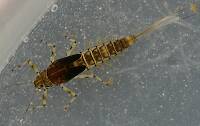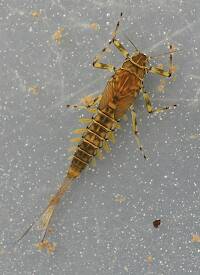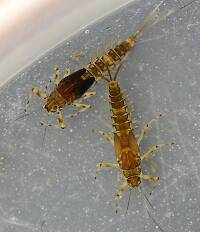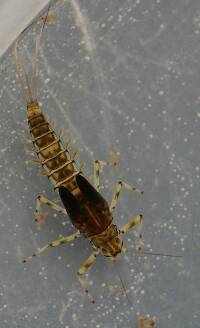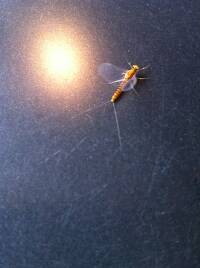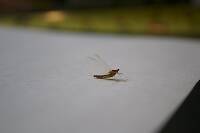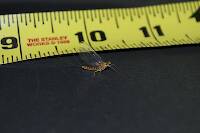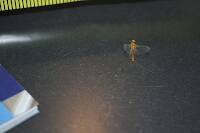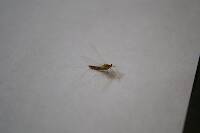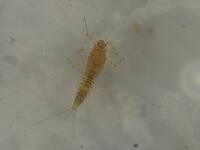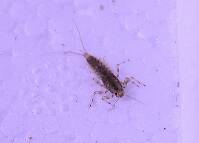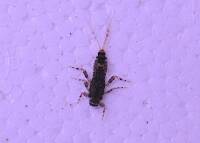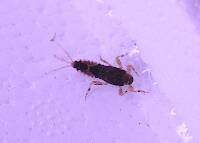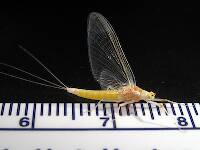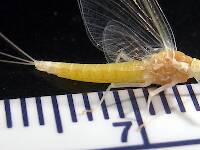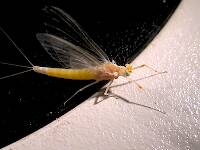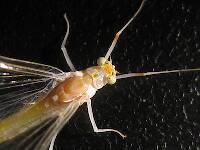
Hex Mayflies
Hexagenia limbata
The famous nocturnal Hex hatch of the Midwest (and a few other lucky locations) stirs to the surface mythically large brown trout that only touch streamers for the rest of the year.
Featured on the forum

This specimen keys pretty easily to Onocosmoecus, and it closely resembles a specimen from Alaska which caddis expert Dave Ruiter recognized as this genus. As with that specimen, the only species in the genus documented in this area is Onocosmoecus unicolor, but Dave suggested for that specimen that there might be multiple not-yet-distinguished species under the unicolor umbrella and it would be best to stick with the genus-level ID. I'm doing the same for this one.

Troutnut is a project started in 2003 by salmonid ecologist Jason "Troutnut" Neuswanger to help anglers and
fly tyers unabashedly embrace the entomological side of the sport. Learn more about Troutnut or
support the project for an enhanced experience here.
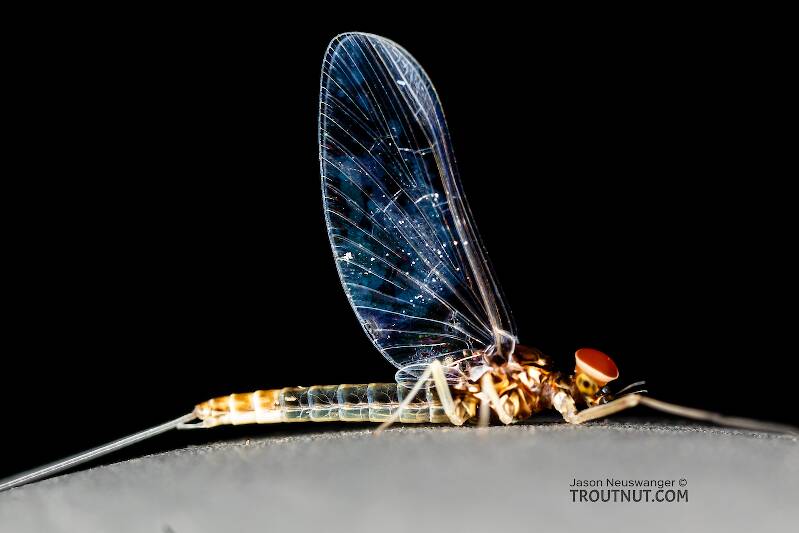
Some notes from identifying this specimen under the microscope:
1. The hind wing has three longitudinal veins, but the third is faint, short (about half the length of the wing), and close to the wing margin.
2. Then antenna is brown fading into white at the tip, and the base is ringed with white.
3. The joints of the tarsal segments on the middle and hind leg have fine black markings.
It was also collected in association with a female spinner.
1. The hind wing has three longitudinal veins, but the third is faint, short (about half the length of the wing), and close to the wing margin.
2. Then antenna is brown fading into white at the tip, and the base is ringed with white.
3. The joints of the tarsal segments on the middle and hind leg have fine black markings.
It was also collected in association with a female spinner.
Taxon on Nov 7, 2020November 7th, 2020, 9:44 am EST
Hi Jason-
I believe this male imago to be Baetis bicaudatus.
I believe this male imago to be Baetis bicaudatus.
Troutnut on Nov 8, 2020November 8th, 2020, 3:25 am EST
Hi Roger,
As I understand it, Baetis bicaudatus has only 2 longitudinal veins in the hind wing. This one has three, with the third being only about half-length and very close to the margin of the wing, but clearly present (especially under my new microscope -- harder to see in the pictures).
This specimen seems to fit very well the description of Baetis alius, but I also don't have information to rule out tricaudatus or flavistriga. In fact I can't find much of a description of the adults of either species, except for the fairly un-detailed original descriptions, which probably aren't terribly relevant now given all the synonyms that have been combined in Baetis since then.
Of the species known to be present in central Idaho, these three seem like the most plausible options. Do you see anything to narrow it down from there?
As I understand it, Baetis bicaudatus has only 2 longitudinal veins in the hind wing. This one has three, with the third being only about half-length and very close to the margin of the wing, but clearly present (especially under my new microscope -- harder to see in the pictures).
This specimen seems to fit very well the description of Baetis alius, but I also don't have information to rule out tricaudatus or flavistriga. In fact I can't find much of a description of the adults of either species, except for the fairly un-detailed original descriptions, which probably aren't terribly relevant now given all the synonyms that have been combined in Baetis since then.
Of the species known to be present in central Idaho, these three seem like the most plausible options. Do you see anything to narrow it down from there?
Jason Neuswanger, Ph.D.
Troutnut and salmonid ecologist
Troutnut and salmonid ecologist
Millcreek on Nov 8, 2020November 8th, 2020, 7:35 am EST
Jason,
I've found a few references to the three species. Don't know if they'll help much. Seems about the best way to go about it would be to raise them from larvae. Since the stream is in Idaho, that seems unlikely.
Anyway, here's what I found.
http://www.ephemeroptera-galactica.com/pubs/pub_m/pubmccaffertyw2008p577.pdf
Mostly larvae but some description of adults.
http://www.insecta.bio.spbu.ru/z/pdf/DurfeeKondratieff1993p227.pdf
Comparison of B. magnus and B. tricaudatus with line drawings of both.
http://www.ephemeroptera-galactica.com/pubs/pub_d/pubdayw1954p29.pdf
Day's original description of B. alius.
https://www.gunnisoninsects.org/ephemeroptera/baetis_flavistriga.html
From Gunnison County on B. flavistriga nymphs and adults.
I've found a few references to the three species. Don't know if they'll help much. Seems about the best way to go about it would be to raise them from larvae. Since the stream is in Idaho, that seems unlikely.
Anyway, here's what I found.
http://www.ephemeroptera-galactica.com/pubs/pub_m/pubmccaffertyw2008p577.pdf
Mostly larvae but some description of adults.
http://www.insecta.bio.spbu.ru/z/pdf/DurfeeKondratieff1993p227.pdf
Comparison of B. magnus and B. tricaudatus with line drawings of both.
http://www.ephemeroptera-galactica.com/pubs/pub_d/pubdayw1954p29.pdf
Day's original description of B. alius.
https://www.gunnisoninsects.org/ephemeroptera/baetis_flavistriga.html
From Gunnison County on B. flavistriga nymphs and adults.
"If we knew what it was we were doing, it would not be called research, would it?"
-Albert Einstein
-Albert Einstein
Troutnut on Nov 8, 2020November 8th, 2020, 3:37 pm EST
Thanks Mark. I have looked through most of those. This specimen seems like a perfect fit for the original description of alius, but I wish I could find some way to rule out the other two.
Jason Neuswanger, Ph.D.
Troutnut and salmonid ecologist
Troutnut and salmonid ecologist
Taxon on Nov 9, 2020November 9th, 2020, 4:50 am EST
Hi Roger,
As I understand it, Baetis bicaudatus has only 2 longitudinal veins in the hind wing. This one has three, with the third being only about half-length and very close to the margin of the wing, but clearly present (especially under my new microscope -- harder to see in the pictures).
This specimen seems to fit very well the description of Baetis alius, but I also don't have information to rule out tricaudatus or flavistriga. In fact I can't find much of a description of the adults of either species, except for the fairly un-detailed original descriptions, which probably aren't terribly relevant now given all the synonyms that have been combined in Baetis since then.
Of the species known to be present in central Idaho, these three seem like the most plausible options. Do you see anything to narrow it down from there?
No, not really, but you have succeeded in convincing me that the most likely candidate is Baetis alius.
Also, am intrigued to learn more about your new microscope.
Millcreek on Nov 9, 2020November 9th, 2020, 7:35 am EST
I think Baetis alius is the most likely of the three. The description certainly seems to fit. Funny these three are extremely common, yet only one is described well.
"If we knew what it was we were doing, it would not be called research, would it?"
-Albert Einstein
-Albert Einstein
Troutnut on Nov 10, 2020November 10th, 2020, 9:19 am EST
I was almost too quick to rule out Roger's suggestion of bicaudatus. I was ruling it out based on the wing venation described by Traver (1935), but McDunnough (1938) says that 3rd longitudinal vein is present in most males of B. bicauduatus too. However, this source confirms that there is "very little sign of the 3rd vein" in the females, whereas this associated female does have a clear but diminutive 3rd vein. So I think bicauduatus is still out.
Jason Neuswanger, Ph.D.
Troutnut and salmonid ecologist
Troutnut and salmonid ecologist
Troutnut on Nov 10, 2020November 10th, 2020, 11:35 am EST
I've added four images from my microscope to this specimen. It's an Amscope 3.5X-180X Simul-Focal Trinocular Stereo Zoom Microscope with an 18MP camera.
I think it's pretty clear that there aren't prominent tubercles on the basal joint of the forceps, which rules out flavistriga. If the genitalia are of the moffati type, it should be tricaudatus. If they are of the intercalaris type, it should be alius. Normally the intercalaris type has a tubercle on the basal joint of the forceps, but supposedly not in alius.
However, I don't find the descriptions and figure in Traver 1935 very helpful as to how to tell the difference between the two types. I sent an SOS to Luke Jacobus with the picture and am hoping he can provide some clarity.
I think it's pretty clear that there aren't prominent tubercles on the basal joint of the forceps, which rules out flavistriga. If the genitalia are of the moffati type, it should be tricaudatus. If they are of the intercalaris type, it should be alius. Normally the intercalaris type has a tubercle on the basal joint of the forceps, but supposedly not in alius.
However, I don't find the descriptions and figure in Traver 1935 very helpful as to how to tell the difference between the two types. I sent an SOS to Luke Jacobus with the picture and am hoping he can provide some clarity.
Jason Neuswanger, Ph.D.
Troutnut and salmonid ecologist
Troutnut and salmonid ecologist
Jmd123 on Nov 11, 2020November 11th, 2020, 12:25 am EST
Wow, nice scope there Jason! And right now it's on sale for half price! I did get myself a really nice used B&L Stereozoom 4 with a ring illuminator (about the same price all together), so I'm set for now except for the camera...but that's one to keep in mind.
Jonathon
Jonathon
No matter how big the one you just caught is, there's always a bigger one out there somewhere...
Troutnut on Nov 12, 2020November 12th, 2020, 6:42 am EST
After exchanging a few emails about this one with Luke Jacobus, we're tentatively calling it tricaudatus -- with "huge air quotes" as Luke put it.
This call is due to the apparent shape of the forceps (although the "type" of the forceps isn't 100 % obvious), and the venation on the hind wings, which is a bit hard to see. I think the third longitudinal vein connects to the margin about half-way up the length of the wing, and there are a couple of small marginal intercalaries.
This call is due to the apparent shape of the forceps (although the "type" of the forceps isn't 100 % obvious), and the venation on the hind wings, which is a bit hard to see. I think the third longitudinal vein connects to the margin about half-way up the length of the wing, and there are a couple of small marginal intercalaries.
Jason Neuswanger, Ph.D.
Troutnut and salmonid ecologist
Troutnut and salmonid ecologist
Millcreek on Nov 12, 2020November 12th, 2020, 12:58 pm EST
Well, I could go for tricaudatis or alius. I've seen male adults that look like these that are hanging out over the bank or shallow water. Only problem is that both species are in the river as nymphs at the same time. I'd be more inclined towards alius because it is better described as an adult.
"If we knew what it was we were doing, it would not be called research, would it?"
-Albert Einstein
-Albert Einstein
Troutnut on Nov 12, 2020November 12th, 2020, 1:00 pm EST
I think the main reason to not go with alius is that alius isn't supposed to have any intercalary veins in the hind wing, and this one seems to have at least two small ones.
Jason Neuswanger, Ph.D.
Troutnut and salmonid ecologist
Troutnut and salmonid ecologist
Millcreek on Nov 12, 2020November 12th, 2020, 1:27 pm EST
Possibly, but I'm not sure hind wing venation is that good a way to differentiate between species in Baetis. There seems to be a good deal of variation even in a species. It could be tricaudatus, but it could be another species.
"If we knew what it was we were doing, it would not be called research, would it?"
-Albert Einstein
-Albert Einstein
Quick Reply
Related Discussions
Topic
Replies
Last Reply
0
Nov 6, 2020
by Troutnut
by Troutnut
2
Nov 12, 2020
by Troutnut
by Troutnut





